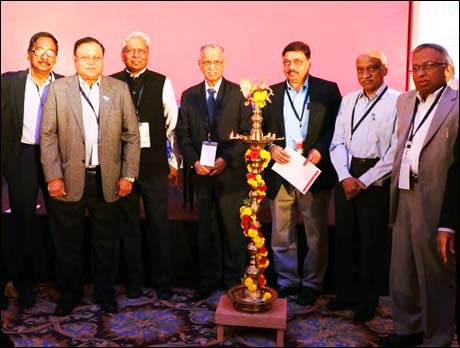
Bangalore, December15 2017: The biggest challenge for India as she aims to achieve exaflop ( one to the power 18 computer operations a second) levels of supercomputing, is talent development said Infosys co-founder N R Narayana Murthy Other challenges he identified were: settling the privacy issue once and for all; change data and tasks from sequential to a parallel structure; remove red tape and bureaucratic delays in implementation, encouraging R&D in both public and private institutions.
He was delivering the keynote at the first National Supercomputing Conclave -- a day long workshop to address software challenges to Exascale computing today. The event saw the National Institution for Transforming India (NITI Aayog), Ministry of Electronics and Information Technology (MeitY), Department of Sciences & Technology and Department of Biotechnology Government of India join hands with the India Electronics and Semiconducctor Association (IESA) to host it.
The National Supercomputing Mission, was launched back in 2015 with a mission is to connect national academic and R&D institutions with a grid of over 70 high-performance computing facilities at an estimated cost of Rs 45 billion ( Rs4,500 crore). T he mission is jointly implemented by the Centre for Development of Advanced Computing (C-DAC) and Indian Institute of Science (IISc).
“With an ever increasing computing demand of the scientific and academic community in the country, NSM has been conceptualized and evolved to keep pace with the international technology trends by empowering academic and R&D institutions spread over the country. The mission was launched in 2015 with the aim to install large number of super-computers in academic and research institutions, national laboratories located in different parts of the country, linked by a computer grid,” said Dr. VK Saraswat, Member, NITI Aayog. “Another objective of this mission is to create a strong and competitive local ecosystem for design, development, manufacturing and utilization of super computers, thereby providing world class computing capabilities to our research scientists, engineering students and high technology start-ups, just like the way they are using personal computers today”, he further added.
Dr. Vijay Bhatkar, the architect of India’s national initiative on supercomputing and Chancellor of Nalanda University, added:“ The National Supercomputing Mission has potential to transform Indian IT Industry to truly high value adding IP based knowledge industry from its essentially service based nature. India must invoke its strengths in mathematics, algorithms, analytics, linguistics and deep learning and move to next level of software development”
“The major goal of National Super Computing Mission is to provide access to state of the art and contemporary super computing infrastructure to our scientific community so that our dream of becoming first rate, world class research community is realized faster” said Prof. N. Balakrishnan, of the Indian Institute of Science
Dr. KD Nayak, Former DG, DRDO & Member NSM-TAC explained that the event brought together some 150 scientific minds from Government, Academia, Research Community, IT Industry, Processor, Accelerator, Server and High Performance Computing OEMs, Professional societies and key users on a common platform to brainstorm and create the roadmap, with an aim to Transform India through Computational Knowledge (TICK) in this critical and strategic space.
Ashwini Aggarwal, Chairman of IESA and Dr Sandeep Garg, President of IESA emphasised on the support by the entire ESDM industry towards meeting this vision goal.